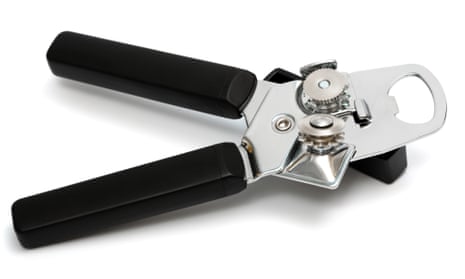Who knew the humble tin opener was such a status symbol in modern society? There was the infamous Mumsnet thread last year when a woman’s sister claimed that “if you have a tin opener in your kitchen, it means you’re poor”, with little regard for those so poor that they can’t afford one. And now the Wall Street Journal has claimed that “millennials” are killing off the tuna trade because we apparently don’t own tin openers.
I must be an anomaly, as I have nine, but then I’ve just finished writing a cookbook, Tin Can Cook, with recipes made entirely from tins, and I needed some backup.
Tins with ringpulls tend to belong to those with slightly more disposable income; look at the Basics and Value ranges next time you are in the supermarket and you will see that they require a tin opener to get into them.
The irony is that those with the least money need an additional piece of kitchen equipment in order to eat the most basic foodstuffs.
My tin openers range from £1 for a plain and military-simplistic butterfly style, to £16 for a battery-operated lump that barely worked with any degree of reliability, and was launched across the kitchen more than once to a cacophony of curse words. A dependable, sturdy, mid-range can opener will cost around £5, and, for many of the food-bank users and people I work with, £5 may as well be £5,000, because when you don’t have it, you don’t have it. In desperate times, when my old can opener packed up, I have hungrily hacked into a tin with a bradawl and a hammer –not particularly hygienic, and an awful lot of work for a reward of some cold baked beans for tea.
We have an odd culinary relationship with tinned food. In higher society, rare and supposedly exquisite goods such as tinned baby octopus, foie gras and caviar come in beautifully crafted, artistically designed tins. At the other end of the spectrum, I fill my shopping trolley with identical white labels, the contents scrawled on the front as though in a child’s hand, with no ringpull on the top, and barely a clue to their contents. Twenty-pence carrots in a tin are cheaper than buying them fresh. Tinned potatoes can be up to a sixth of the price of even the cheapest fresh varieties. Sweetcorn, mushy peas, beans, lentils, are all basic staples that can be thrown together into a variety of surprising meals. Tinned sardines contain almost an entire day’s recommendation of vitamins D and B12. Tins are a storecupboard staple for every household, but so, too, are the tools to get inside them.
I’m currently in the early stages of setting up an initiative to donate basic cooking equipment to people in need of it – starting with tin openers. Food banks already make “cold boxes” – parcels of food that with cans that all have ringpulls and can be eaten cold, such as cooked meats, baked beans, tomato soup. It’s a grim indictment of the realities of our times that people need to consider this, let alone do it. If the thought of cold tomato soup makes you shudder, take it from a veteran, it’s like a creamy gazpacho, but in a decent society, nobody should have to find out. Perhaps as part of the current Christmas donations drive to food banks, you could consider slinging a can opener in along with the tins and packets. Even a £1 military-style can opener opens a world of possibilities. I’m yet to find a decent battery operated one for bad arthritis days that doesn’t cost the earth, so if you find one, do let me know!
